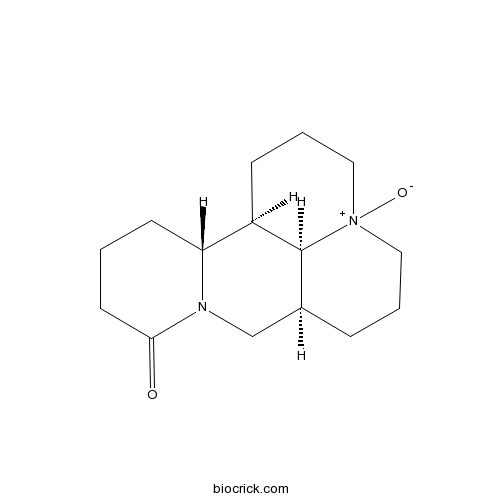InChI=1S/C15H24N2O2/c18-14-7-1-6-13-12-5-3-9-17(19)8-2-4-11(15(12)17)10-16(13)14/h11-13,15H,1-10H2/t11-,12+,13+,15-,17?/m0/s1
Oxymatrine, one of the major components of Sophora flavescens ait, has exhibited anti-hepatitis virus infection, anti-hepatic fibrosis, anti-inflammation, anti-anaphylaxis and other immune-regulation, it induces human pancreatic cancer PANC-1 cells apoptosis via regulating expression of Bcl-2 and IAP families, and releasing of cytochrome C.[1]
Oxymatrine is proven to protect ischemic and reperfusion injury in liver, intestine and heart, this effect is via anti-inflammation and anti-apoptosis, it has protective effect applies to ischemic injury in brain to reduce infarct volume induced by pMCAO, this effect may be through the decreasing of NF-kappaB expression.[2]
Oxymatrine has anti-inflammatory activity, it can reduce the serum levels of TNF-α, IL-6, and the expression of NF-κB and ICAM-1 in colonic mucosa in dextran sulfate sodium (DSS)--induced colitis of rats, indicates that oxymatrine may ameliorate the colonic inflammation and thus alleviate diarrhea and bloody stool.[3]
Oxymatrine has a beneficial effect on acute lung injury induced by oleic acid in mice and may inhibit the production of proinflammatory cytokine, TNF-alpha, by means of the inhibition of p38 MAPK.[4]
Oxymatrine has inhibition of hepatitis B virus in vivo, it (200 mg/kg/d,20day )can reduce thecontents of HBsAg and HBcAg in transgenic miceliver, and longer treatment time and larger dosage do not yield better effects.[5]
Oxymatrine can attenuate diabetes-associated cognitive deficits in rats, which is associated with oxidative stress, inflammation and apoptotic cascades.[6]
Oxymatrine can induce cell cycle arrest and apoptosis, which makes it a potentially useful agent for targeting cancer cells; it causes a dose-dependent reduction in the proliferation of MCF-7 cells and a decrease in SP cells, the growth inhibitory effects of oxymatrine treatment on MCF-7 cells may be due to the inhibition of SP and Wnt/0205-catenin signaling pathway. [7]
Oxymatrine and astragalus polysaccharide can synergistically improve the immune efficacy of Newcastle disease vaccine in chicken, because of astragalus polysaccharide and oxymatrine possesses synergistical immunoenhancement.[8]
English website: Oxymatrine
Japanese website: Oxymatrine
Chinese website: Oxymatrine
[1] Qi L, Xiao X, Wei X, et al. J Exp Clin Cancer Res, 2011, 30(1):66-66.
[2] Zhang X J, Yang C H, Fan H G. Brain Res, 2009, 1268:174-80.
[3] Zheng P, Niu F L, Liu W Z, et al. World J Gastroenterol, 2005, 11(31):4912-5.
[4] Lao L, Rao S Y, Gong Z N, et al. J Ethnopharmacol, 2005, 98(1-2):177-83.
[5] Xiao, Song, Chen, et al. World J Gastroenterol, 2001, 7(1):49-52.
[6] Suo-bin, WANG, Jian-ping. Acta Pharmacol Sin, 2014, 35(3):331-8.
[7] Zhang Y, Piao B, Zhang Y, et al. Med Oncol, 2011, 28(1):99-107.
[8] Chen Y, Wang D, Hu Y, et al. Int J Biol Macromol, 2010, 46(4):425-8.
[9] Liu J, Yuan L M, Li-Qin H E, et al. Chemical World, 2009, 50(7):410-1.



